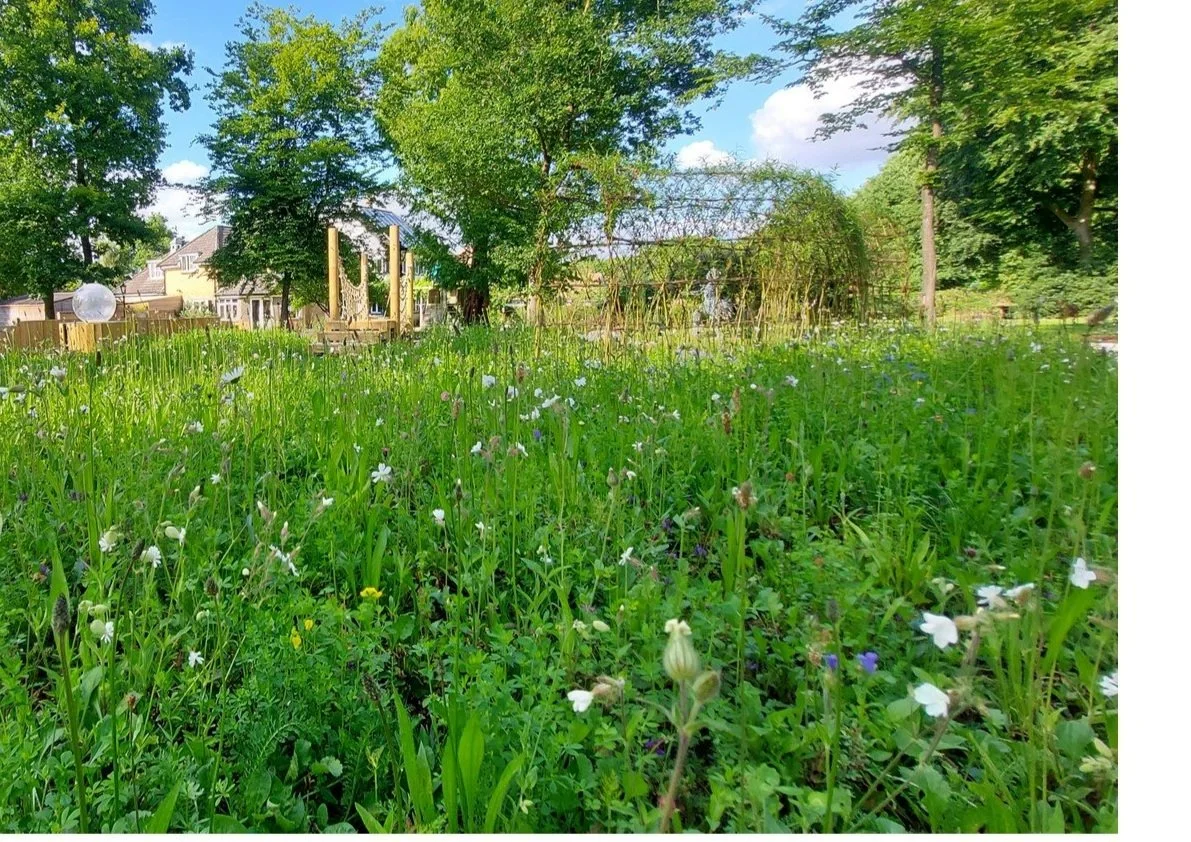When & How to Cut a Wildflower Meadow
Wildflower meadows and gardens have always been popular given their vibrant colours and variety of plants. However, in recent years they have grown in importance as more people recognise their value in supporting the environment around them.
Increasingly, eco-conscious gardeners and those seeking low-maintenance options for their own green spaces, are turning over sections or even whole swathes of their outdoor space to wildflowers.
This rise in popularity has seen a variety of pre-packaged solutions emerge, allowing gardeners to use “flower-bombs”, sachets of seeds with a mix of varied wildflowers, that slowly transform into beautiful meadows or even specialist wildflower turfs that can instantly transform any outdoor space or structure.
But, just how do you strike the balance between a beautiful riot of colourful wildflower blooms and avoiding an unwieldy garden patch that looks neglected? The good news is some light maintenance once or twice a year can be all that stands between you and a little pocket of eco-friendly beauty.
Should you mow a wildflower garden?
It is up to personal preference as to how actively you wish to mow or cut back a wildflower garden. However, the approach you take can help to achieve a variety of different results. Unlike traditional gardening, when it comes to a wildflower patch it is very much a case of “less is more” on the maintenance front.
A wildflower garden that is only cut back minimally will take on the appearance more akin to a wildflower meadow, with a variety of the larger wildflower species and tall grasses being the most visually apparent aspects.
Alternatively, if you choose to keep your wildflower lawn mown back or at a shorter height, this will prevent the larger species establishing. A more enthusiastically trimmed wildflower garden will allow the smaller variations of wildflower to establish without being overrun by the larger types. This can allow for more individual blooms to be seen and more variety of colour.
A careful balance has to be struck if you intend to mow more often, being too enthusiastic can hamper flowers establishing and promote a grassier appearance which can be more akin to an uncared-for lawn.
Can you leave a meadow uncut?
It is somewhat of a myth that a wildflower meadow takes no care and achieves a varied and colourful palette if nature is left to take it’s course. Even with wildflowers, nature benefits from a bit of a helping hand.
A meadow that is left completely uncut will eventually see the variety of flowers overrun as the more dominant grasses take over and squeeze out the less hardy or delicate varieties of plant.
Cutting back in a controlled manner enhances what nature does best. Making space allows for a plethora of different colourful wildflowers to thrive while still allowing some of the taller ferns and grasses to find a place. This makes for a visually interesting wildflower meadow with variations in colour and height.
When should I cut my wildflower meadow?
A general rule is that a wildflower meadow will require at least one cut per year. However, for maximum effect two, well-timed trimming seasons a year can serve to prolong flowering and colour for maximum effect.
There is no specific date that can be given, especially with our evermore erratic temperatures and shifts in weather patterns. Rather than suggesting a cut in Autumn for instance, it is better to monitor the meadow for signs that plants are reaching the end of their flowering and are soon to shed their seed which could in theory be just at the end of summer or even into early winter depending on the specific climate that year.
It is key however not to cut back prior to seeds being fully developed. Cutting back your wildflowers too early can impact their ability to grow back year on year. Equally, leaving any cutting too late can allow any pesky grasses to become to established which may strangle some of your flowers.
How to cut a wildflower meadow
Put away the ride on mower or the large petrol lawnmower, cutting a wildflower meadow is a much lighter affair. If you have picked an ideal time where flowers are getting ready to shed seed, a stick makes a great, if somewhat rustic, tool to knock the seed heads from their stems allowing them to land on the soil below. Getting seeds to the floor of your meadow in large numbers like this encourages as many as possible to germinate for the next season.
In terms of trimming back, the stems and any longer grasses left behind which may be growing excessively tall need to be cut down. A strimmer or hand shears make a good option for tackling these lengthy stems. Avoid the temptation to take too much off, taking each stalk down to 3 or 4 inches in height helps to clear space for new sprouts without making the meadow appear barren.
A thorough watering of the soil will also help to create the best chance of supporting re-growth for the next season. Some people will choose to leave fallen seed heads and stems on the meadow through winter, prior to raking them away in spring. The idea is this allows seeds the maximum time on the soil while supporting local birds who will happily pick of any remaining fallen seeds which have not taken root.
A tip when dealing with any cuttings from your wildflower patch is to remember not to deposit them in your compost bin. It is highly likely that some seeds will remain and, given some wildflowers’ propensity for growing even in sub-par soil, they may quickly flourish and grow in your compost bin. While this may be pretty it will undo all your prior composting.
Do wildflowers grow back after cutting?
Well-established wildflowers will tolerate more significant cutting back, and a good trim will even help them to establish a healthy regrowth when the weather permits.
Not only is cutting back helpful to the plant, it adds an extra element of visual interest to your meadow as wildflowers will often redistribute their growth and take on a different appearance the following year. This can make space for different wildflowers to grow in amongst and beside each other.
Skilled or adventurous gardeners can use more complicated patterns of cutting back at different times of the year to change the overall height and composition of the meadow year on year.
Are wildflower meadows low maintenance?
The concept of low maintenance can differ from person to person. As mentioned previously, there can be a myth that a wildflower garden or meadow requires no intervention, but this is simply not true.
Some intervention of cutting back and clearing foliage is required at least once, ideally twice a year. However, this should be considered seriously low maintenance compared to managing a traditional garden.
As well as being less time consuming, a wildflower meadow has the added benefit of being good for the environment, offering up a veritable paradise for all types of bees, insects, and birds. This makes it accessible and appealing to those who may be intimidated by other planting approaches.
A wildflower patch can also be visually stunning by creating variety in an otherwise more ordered or curated garden.
Should wildflowers be deadheaded?
Wildflowers can be deadheaded but not all varieties strictly need this, many types will effectively deadhead themselves with flowerheads falling off after wilting.
As mentioned above, roughly knocking any flower heads to the floor just before they are due to release seeds can help with germination.
Some wildflower varieties do not in fact re-grow from the top and will generate an entirely new stem and flower after cutting back, therefore deadheading would not enhance growth. However, it may be more visually appealing to remove dead flowerheads.
Do wildflowers grow back every year?
If conditions are favourable, the vast majority of wildflowers will come back year on year.
Just because they return each year however, does not mean they will flower every year. They may produce lesser blooms or only create greenery. Likewise, many varieties may not bloom at all in their first or even second year, but once established will reliably flower each subsequent year.
The length of time that each species of wildflowers blooms can also vary significantly - from types of daisies that may be in flower for months, to more delicate blooms that may only last a few weeks. This means the appearance and mix of flowers may shift in your wildflower meadow throughout a season. This can be one of the reasons that people enjoy wildflower patches so much as they can change much more quickly than more traditional gardens.
One of the most noted, rarer blooming wildflowers is the Vipers Bugloss. A fantastic tall blue plant full of blue colour and rich in nectar. This plant puts so much energy and nutrients into creating its vivid blue flowers than it can take years to shore up its reserves enough to flower again. This means the plant may be present in your meadow but you may only see it in full bloom once every two to three years, with no guarantee which year it will be.
Nature really is astounding sometimes.

